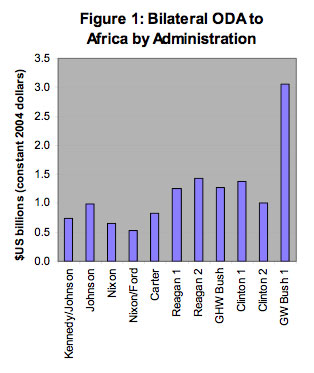Under President George W. Bush U.S. assistance to Africa has sharply increased,
reaching $4.2 billion in 2005, nearly four times the level of 2000, and more
than twice the level of any previous administration.
Here’s the chart:

(Via PSDBlog)
Comments are closed.

Sir — [I can pretend this is the FT]
Finally – a post fit for a comment by a political science geek.
The historical neglect of Africa in US Foreign policy since the end of the Cold War still rests clearly in everyone’s minds. As my friend and colleague, Bob Ostergard has pointed out, “The disappearance of the Soviet ‘threat’ in Africa after the Cold War also marked the beginning of the USA’s diplomatic departure. Within three years of the fall of the Berlin Wall, the State
Department’s Bureau of African Affairs lost 70 positions, and consulates in
Kenya, Cameroon and Nigeria were scheduled to be closed. The US Agency for International Development’s Africa desk lost between 30 and 40 officers out of a total of a normal staff size of 130 (Michaels, 1992: 96—98)”.
Well – the Bush Admin in particular has decided to reverse course. Given the geostrategic competition that is emerging over oil (Nigeria, Chad and even the Sudan) and influence in Africa between the United States and China the substantial rise in bilateral ODA is not suprising. The recent press covereage in the Finacial Times of the rise of China aid, military assistance and training and diplomacy in Africa speaks precisely to this point. For the financial buffs on who read this blog — just ask yourself why Nigeria got such a tremendous and probably undeserved Paris Club deal…despite tremendous oil windfalls.
For those who don’t normally pay attention to testimony by DOD official in Congress, yesterday it was widely reported (for example in the Washington Post) that the United States just announced a plan to create a new unified African Command [merging elements of Cold War oriented CENTCOM and European Command]. According to Robert Gates’ testimony, this new command will be responsible for US military operations everywhere on the African continent with the exception of Egypt which will stay under CENTCOM’s jurisdiction.
Unfortunately, history suggets that the US will probably make as big a of a mess this time around in Africa as we did during the Cold War. Even China’s more sophisticated People’s War strategy of winning hearts and minds has backfired in interesting ways — to help secure influence in Sudan, the Chinese invested billions in infrastructural development, including the building of roads. Well guess what the roads were used for? Improving the efficiency of ethnic cleansing!
It would be interesting to see a year by year graph of Chinese assistance to Africa, transposed over the growth in US assistance. Any chance of doing this?
Wouldn’t it be great if we could have an “aid to Africa” race to replace the “arms race” of the Cold War? Somehow I doubt it — and of course everything would depend on what you consider Chinese “assistance” (as opposed to “investment”) in Africa.
For those interested, the United States makes comparison of its own foreign aid data pretty easy across both programs (for example military vs agricultural) and countries and regions. The data is compiled in whats called the Green Book.
[US Overseas Loans and Grants]
For ODA data from the OECD:
I am trying to hunt down data on China, but I don’t think it is readily available.